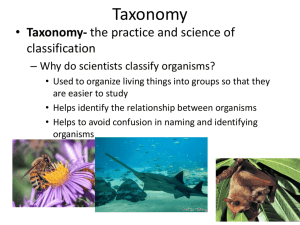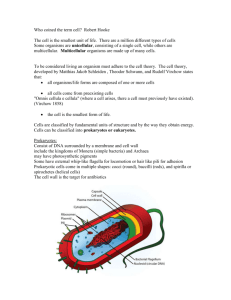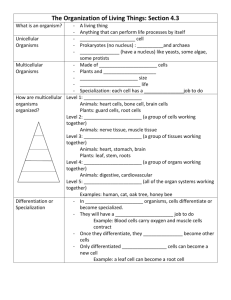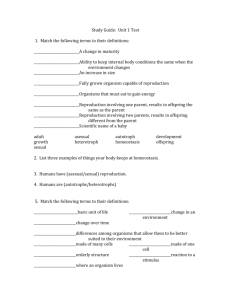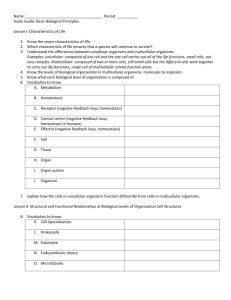Study Guides
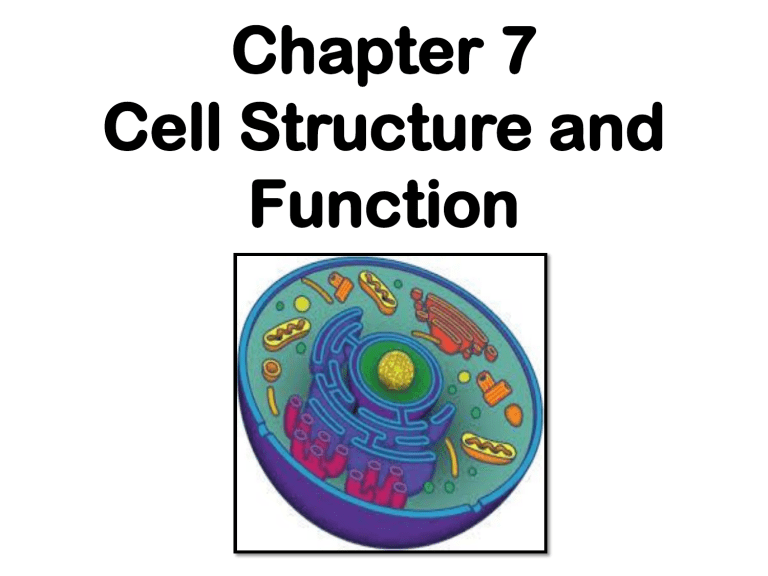
Chapter 7
Cell Structure and
Function
7-1 Life is Cellular
The Discovery of the Cell
• Because there were no instruments to make cells visible, the existence of cells was unknown for most of human history.
• This changed with the invention of the
microscope.
Early Microscopes
• In 1665, Robert Hooke used an early compound microscope to look at a thin slice of cork, a plant material.
• Cork looked like thousands of tiny, empty chambers.
• Hooke called these chambers “cells” after tiny rooms called cells.
• Cells are the basic units of life and contain living matter.
Hooke’s Drawing of Cork Cells
• Around the same time, Anton van
Leeuwenhoek used a single-lens microscope to observe pond water and other things.
• The microscope revealed a world of tiny living organisms.
The Cell Theory
• In 1838, Matthias Schleiden concluded that all
plants were made of cells.
• In 1839, Theodor Schwann stated that all
animals were made of cells.
• In 1855, Rudolph Virchow concluded that new cells were created only from division of existing cells.
• These discoveries led to the cell theory.
The cell theory states:
• All living things are composed of cells.
• Cells are the basic units of structure and function in living things.
• New cells are produced from existing cells.
Exploring the Cell
• New technologies allow researchers to study the structure and movement of living cells in great detail.
Prokaryotes and Eukaryotes
• Cells come in a variety of shapes and sizes.
• All cells have 2 characteristics in common
1. They are surrounded by a barrier called a
cell membrane.
2. At some point they contain the molecule that carries biological information- DNA.
• Cells are classified into 2 categories, depending on whether they contain a nucleus.
• The nucleus is a large membrane-enclosed structure that contains the cell's genetic material in the form of DNA.
• The nucleus controls many of the cell's activities
(nucleus = the brain of the cell)
*Eukaryotes are cells that contain nuclei.
*Prokaryotes are cells that do not contain nuclei.
(nuclei is plural form of nucleus)
What are the characteristics of prokaryotes and eukaryotes?
Prokaryotes
• Prokaryotic cells have genetic material that is not contained in a nucleus.
• Prokaryotes do not have membrane-bound organelles.
• Prokaryotic cells are generally smaller and simpler than eukaryotic cells.
• Bacteria are examples of prokaryotes.
Eukaryotes
• Eukaryotic cells contain a nucleus in which their genetic material is separate from the rest of the cell.
• Eukaryotic cells are generally larger and more complex than prokaryotic cells.
• Eukaryotic cells generally contain dozens of structures and internal membranes.
• Many eukaryotic cells are highly specialized.
• Plants, animals, fungi, and protists are all examples of eukaryotes.
7-4 The Diversity of
Cellular Life
• The _______________________among living things arise from the ways in which cells are specialized to perform certain tasks and the ways in which cells associate with one another to form ______________________organisms.
Unicellular Organisms
• Unicellular _____________________are made up of only one cell.
• Unicellular organisms ________________life on Earth.
• The prefix uni- means one.
• Unicellular organisms include some fungi and protozoans, ______________, and bacteria.
• They do grow, respond to their environment,
________________energy, and reproduce.
Amoeba
Bacteria (bacillus)
Bacteria (cocci)
Fungi
Paramecium
Multicellular Organisms
• ______________________that are made up of many cells are called multicellular.
• There is a great variety among multicellular
___________________.
• The prefix multi- means many.
• There is a ________________of multicellular organisms.
• Cells throughout an organism can develop in
________________ways to perform different tasks.
• This process is called cell specialization.
Specialized Animal Cells
• Animal cells are _____________in many ways.
• Red blood cells transport oxygen.
Cells in the pancreas produce proteins.
Muscle cells allow movement.
Specialized Plant Cells
• Plants ________________________carbon dioxide, oxygen, water vapor, and other gases through tiny openings called stomata on the undersides of leaves.
• Highly specialized cells, known as guard cells,
____________________this exchange.
Stomata enclosed by guard cells.
Levels of Organization
• The levels of organization in a multicellular
___________________are:
• individual cells
• tissues
• organs
• organ systems
In multicellular organisms, ____________are the first level of organization.
Tissues
• Similar cells are grouped into units called tissues.
• A tissue is a group of similar cells that
________________a particular function.
• Most ________________have four main types of tissue:
• muscle
• epithelial
• nervous
• connective
Organs
• Organs are groups of tissues that work together to ___________________a specific function.
Organ Systems
• In most cases, an organ completes a series of
____________________tasks.
• A group of organs that work together to perform a __________________function is called an organ system.
1. Cell specialization is characteristic of a)bacteria.
b)all unicellular organisms.
c)yeasts.
d)multicellular organisms.
2. Which of the following cells is specialized for contraction? a)muscle cell b)red blood cell c)pancreatic cell d)nerve cell
3. The stomach is an example of a(an) a)tissue.
b)organ.
c)organ system.
d)organism.
5. Which of the following would probably contain the greatest variety of specialized cells?
a)an organ system b)a tissue c)an organ d)a multicellular organism


